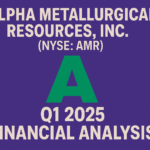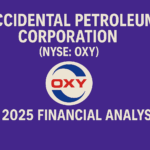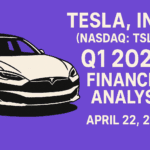Warrior Met Coal Inc. (HCC) Stock Analysis
Warrior Met Coal (NYSE: HCC) Stock Analysis
Sector: Metallurgical Coal / Mining
Analysis Date: February 23,2025
1. Company Overview
Warrior Met Coal is a U.S.-based miner focused primarily on the production and export of premium metallurgical coal (also known as “met coal” or “coking coal”) used in steelmaking. The company operates mines in Alabama and sells coal globally, particularly to steel manufacturers.
Strategic Highlights
- Metallurgical Coal Focus: Met coal prices can be volatile but typically trade at a premium to thermal coal.
- Strong Export Orientation: Warrior’s customer base is global, with a large portion of sales to Europe, South America, and Asia.
- Low-Cost Producer: The company’s mines are known for high-quality, low-cost production, providing some resilience in cyclical markets.
2. Financial Performance
a. Revenue & Growth
- TTM Revenue: $1.53 Billion
- Revenue Growth (YoY): -19.06% (TTM)
- The revenue decline is partly reflective of fluctuating met coal prices and production volumes.
Analysis:
After experiencing strong revenue expansion when met coal prices were high, Warrior Met Coal now faces a revenue pullback due to lower pricing and/or production constraints. The company’s performance is sensitive to global steel demand and commodity price cycles.
b. Profitability
- TTM Net Income: $250.60 Million
- EPS (TTM): $4.79
- Profit Margin (TTM): ~16.43%
Analysis:
Despite a year-over-year revenue decline, Warrior Met Coal remains profitable, indicating the company’s relatively low-cost structure. The profit margin around 16% is solid for a commodity-driven business but can vary widely based on met coal pricing and operational factors (e.g., labor, weather disruptions).
c. Margins
- Gross Margin (TTM): 30.98%
- Operating Margin (TTM): 16.75%
Analysis:
The gross margin near 31% suggests a decent cost discipline in mining operations, though it’s down from higher levels when met coal prices peaked. The operating margin at ~17% further highlights decent operational efficiency, though margins can swing with commodity cycles.
d. Free Cash Flow
- Operating Cash Flow (TTM): $367.45 Million
- Capital Expenditures (TTM): -$457.22 Million
- Free Cash Flow (TTM): -$89.77 Million
Analysis:
Warrior Met Coal’s free cash flow is currently negative (~-$90 million), largely due to elevated capital expenditures (possibly for mine development or expansions). While the company typically generates solid operating cash flow, heavy capex can push FCF negative in the short term.
3. Balance Sheet & Liquidity
- Cash & Short-Term Investments: $506.17 Million
- Total Debt: $173.04 Million
- Net Cash Position: $333.13 Million (i.e., $6.34 per share)
- Equity (Book Value): $2.09 Billion
Analysis:
Warrior Met Coal maintains a net cash position (~$333 million). The low Debt/Equity ratio (~0.08) and high current ratio (~5.20) reflect a conservative balance sheet, providing resilience amid commodity price volatility. This strong liquidity profile can help weather cyclical downturns in coal pricing.
4. Valuation
- PE Ratio (TTM): 9.65
- Forward PE: 11.86
- PS Ratio: 1.58
- EV/EBITDA (TTM): 5.05
- Dividend Yield: 0.69%
Analysis:
Valuation multiples are relatively modest compared to broader market averages, reflecting the inherent volatility and cyclical nature of the coal industry. The EV/EBITDA ratio around 5 suggests a market view that is cautious on long-term coal demand, despite the specialized nature of met coal. The company does pay a small dividend (0.69% yield).
5. Market Performance
- 52-Week Price Change: -17.01%
- Beta (5Y): 1.09
Analysis:
Warrior Met Coal’s share price has declined ~17% in the past year, in line with softening met coal prices and general commodity market fluctuations. With a beta near 1.09, the stock’s volatility is slightly above the broader market’s, typical of cyclical commodity equities.
6. Risks & Considerations
1. Commodity Price Risk: Earnings heavily depend on met coal prices, which are influenced by global steel demand and macroeconomic conditions.
2. Operational / Labor Risks: Mining operations can be disrupted by labor disputes, weather events, or geotechnical issues.
3. Environmental & Regulatory: The coal industry faces ongoing environmental scrutiny and potential policy changes that could impact production or demand.
4. Customer Concentration: A few large steel producers often represent a significant portion of sales; any shift in their purchasing can impact revenue.
5. Capex & FCF Volatility: Substantial capital expenditures can cause swings in free cash flow, as seen in the TTM negative FCF.
7. Conclusion
Pros:
- Specialized Met Coal: Focus on metallurgical coal, essential for steelmaking, can fetch premium pricing relative to thermal coal.
- Solid Balance Sheet: Net cash position (~$333 million) and minimal leverage provide financial flexibility.
- Competitive Cost Structure: Relatively low-cost operations in Alabama, beneficial in a cyclical commodity market.
Cons:
- Cyclical Commodity Exposure: Revenue and earnings can fluctuate significantly with global steel cycles and met coal pricing.
- High Capex Leading to Negative FCF: Ongoing capital investments have driven negative free cash flow in the TTM.
- ESG & Policy Risks: Coal mining remains under environmental and regulatory pressures that could affect future demand or operational constraints.
Final Note:
Warrior Met Coal offers exposure to the metallurgical coal market with a strong balance sheet and historically robust operating margins. However, its fortunes are tied to the global steel industry and commodity price cycles, resulting in volatility. Investors considering HCC should be prepared for cyclical swings and keep an eye on capex spending, met coal price trends, and potential ESG/regulatory developments.
Disclaimer:
This analysis is for informational purposes only and does not constitute investment advice. Investing involves risks, including the potential loss of principal. Always consult a qualified financial advisor before making investment decisions.





